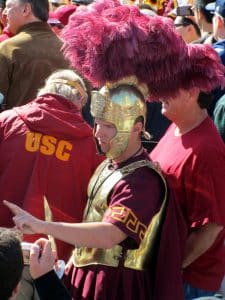College life is more than just academics, and at the University of Southern California, commonly known as USC, social activities play a pivotal role in shaping a student’s overall experience. This article is a deep dive into the vibrant social life at USC, the impact of being located in Los Angeles, and how students manage social challenges while envisioning the future of social life at USC.
Understanding the USC Social Scene
The social scene at USC is dynamic and diverse, made up of a range of activities that cater to every student’s interests. With a bustling Greek life, an array of student organizations, and pulsating social events, the social life at USC is set against a backdrop of southern Californian charm balanced with academic rigor.
At USC, the social scene is not just about having a good time; it’s about building connections, exploring passions, and creating lifelong memories. From the moment students step foot on campus, they are greeted with a vibrant and inclusive community that encourages them to get involved and make the most of their college experience.
The Role of Greek Life at USC
Greek life is a quintessential part of the USC experience. For many students, fraternities and sororities offer a sense of camaraderie and adventure. This is not just a network of peers, but a family away from home where they can form deep and enduring relationships.
Joining a fraternity or sorority at USC means becoming part of a rich tradition that dates back decades. These organizations foster a sense of belonging and provide a support system for students throughout their college journey. From philanthropy events to social mixers, Greek life offers a wide range of activities that cater to different interests and passions.
Aside from social fraternity and sorority activities, these organizations also emphasize their members’ academic excellence, community service, leadership, and personal development. They are the vital epicenters where USC students get to refine their skills, join forces for good causes, and create memories of a lifetime.
USC’s Diverse Student Organizations
Apart from Greek life, USC hosts over 800 student organizations that cater to a broad spectrum of interests from academic, cultural, environmental, political, to recreational and sports organizations. These provide a platform for students to explore their passions, enhance their leadership skills, and ultimately enrich their university experience.
Whether it’s the Model United Nations, the Environmental Student Assembly, or the Entrepreneur Club, there’s an organization for everyone. It gives students an opportunity to shape their individuality, build networking skills, and cultivate lifelong friendships.
Being part of a student organization at USC means being part of a community that shares similar interests and goals. It’s a chance to collaborate with like-minded individuals, participate in events and initiatives, and make a positive impact on campus and beyond.
Social Events and Traditions at USC
USC is well-renowned for its vibrant social events and traditions. From welcome week concerts, and tailgating at home football games, to the annual Springfest music festival, these events epitomize the Trojan spirit. They serve as bonding opportunities, providing the perfect setting for students to unwind and create unforgettable moments.
One of the most anticipated events at USC is the annual homecoming celebration. It brings together current students, alumni, faculty, and staff to celebrate their shared Trojan pride. The campus buzzes with excitement as everyone comes together to enjoy a week filled with activities, including the homecoming parade, bonfire rally, and the crowning of the homecoming king and queen. It is a testament to the charisma and unity that defines USC.
Additionally, USC hosts a variety of cultural events throughout the year, showcasing the diverse backgrounds and talents of its student body. From cultural festivals to art exhibitions, these events provide a platform for students to celebrate their heritage and share their unique perspectives with the USC community.
Overall, the social scene at USC is a vibrant tapestry of opportunities, experiences, and connections. It’s a place where students can explore their passions, build lifelong friendships, and create memories that will last a lifetime.
The Impact of Los Angeles on USC’s Social Life
Los Angeles, a melting pot of diverse cultures, undeniably impacts the vibrancy of USC’s social scene. With its culturally rich venues, Hollywood’s proximity, and abundant sporting events, the city serves as an extender of USC’s campus, offering students access to myriad experiences.
Exploring the City’s Cultural Scene
Frequently dubbed as the creative capital of the world, Los Angeles’s cultural scene is a treasure trove. It offers USC students an opportunity to expand their horizons by visiting world-class museums, attending music and arts festivals, or exploring the city’s historic neighborhoods.
From soaking up contemporary art at The Broad to enjoying live concerts at the Hollywood Bowl, USC students are exposed to a diversified cultural environment that harmoniously complements their campus life.
Los Angeles is home to some of the most renowned museums in the world. USC students can spend hours exploring the exhibits at the Los Angeles County Museum of Art (LACMA), which houses an extensive collection spanning thousands of years and various art forms. The Getty Center, perched atop the Santa Monica Mountains, offers breathtaking views of the city and showcases European paintings, sculptures, and decorative arts.
For music lovers, Los Angeles provides a plethora of options. The Walt Disney Concert Hall, designed by renowned architect Frank Gehry, is a masterpiece in itself and hosts performances by the Los Angeles Philharmonic. The Troubadour, a historic music venue, has seen legendary performances by artists such as Elton John, Joni Mitchell, and The Eagles.
Exploring the city’s historic neighborhoods is like stepping back in time. From the iconic Hollywood Boulevard with its Walk of Fame to the vibrant streets of Chinatown, USC students can immerse themselves in the rich history and diverse cultures that make up the fabric of Los Angeles.
USC’s Proximity to Hollywood and Entertainment Opportunities
USC’s proximity to Hollywood provides students with unparalleled access to entertainment opportunities. Whether interested in film, television, or music, numerous USC students intern or work part-time in these industries, gaining hands-on experience and networking with professionals.
Moreover, this connection to Hollywood often facilitates enriching workshops, guest lectures from industry giants, and premiere movie screenings, keeping students closely entwined with the entertainment world.
USC’s School of Cinematic Arts, one of the most prestigious film schools in the world, further strengthens the university’s ties to the entertainment industry. Students have the chance to learn from acclaimed filmmakers, collaborate on projects, and showcase their work at renowned film festivals.
Los Angeles is not only the center of the film and television industry but also a hub for the music industry. USC students interested in pursuing a career in music can take advantage of the city’s vibrant music scene. From performing at iconic venues like The Roxy and The Troubadour to attending industry events and networking with professionals, USC students have a unique opportunity to immerse themselves in the world of music.
Sports and Recreation in Los Angeles
Los Angeles is a paradise for sports enthusiasts. From cheering on the USC Trojans to supporting local professional teams like the Dodgers, Lakers, or Rams, sports play a significant role in USC’s social landscape. Apart from spectating, students have access to world-class recreational facilities and outdoor adventures, promoting a healthy and active lifestyle.
The USC Trojans have a rich athletic tradition, with successful teams in football, basketball, and various other sports. Attending USC sporting events is not just about supporting the teams; it’s about being part of a passionate community that rallies behind their athletes.
In addition, the city’s stunning beaches, hiking trails, and parks offer a leisurely respite from academic rigor, thus further nurturing a balanced lifestyle amongst students.
Los Angeles is famous for its beautiful beaches, and USC students can take advantage of the sunny weather by spending time at popular spots like Santa Monica Beach, Venice Beach, or Zuma Beach. Whether it’s surfing, playing beach volleyball, or simply relaxing under the sun, the beach culture in Los Angeles is an integral part of USC’s social life.
For those who prefer exploring nature, Los Angeles offers a wide range of hiking trails with breathtaking views. From the iconic Griffith Observatory hike to the scenic trails in Runyon Canyon Park, USC students can escape the hustle and bustle of campus life and connect with nature.
Furthermore, the city’s parks provide a tranquil setting for picnics, outdoor workouts, or simply unwinding with friends. Places like Exposition Park, Echo Park, and Griffith Park offer green spaces where students can enjoy a game of frisbee, have a barbecue, or take a leisurely stroll.
Navigating Social Challenges at USC
While USC’s social scene offers eye-opening experiences and opportunities, it can be challenging, requiring balance, resilience, and a support network.
Attending the University of Southern California (USC) is an exciting and transformative experience. As students embark on their college journey, they are introduced to a vibrant social scene that is teeming with possibilities. However, navigating this social landscape can sometimes be overwhelming, as students must find a way to strike a balance between their academic responsibilities and their desire to explore and engage with their peers.
Balancing Academics and Social Life
The transition to college life can be overwhelming for students due to the newfound freedom and wealth of options. While venturing into social groupings and activities is crucial to personal growth, creating a balance with academic responsibilities is equally important. Recognizing the necessity of effective time management is usually the first step in this tightrope walk.
At USC, students have access to a range of resources and workshops designed to help them navigate this delicate balance. The Kortschak Center for Learning and Creativity, for instance, offers valuable support to students, assisting them in managing their time and academic expectations. Through personalized guidance and strategies, students can develop effective study habits and prioritize their commitments, ensuring that they make the most of their college experience both academically and socially.
Dealing with Social Pressure at USC
While the social scene at USC is undoubtedly exciting, it can also come with its fair share of challenges. Social pressure is a common issue faced by students as they navigate their way through college. The desire to fit in, be active in Greek life, or participate in multiple organizations can often lead to stress and burnout.
Recognizing the importance of individuality and self-care, USC encourages students to accept that it’s okay not to partake in everything. It’s vital to recognize one’s limits and pursue opportunities that genuinely bring joy and personal development rather than just conforming to societal expectations. By embracing their unique interests and passions, students can create a meaningful and fulfilling college experience that aligns with their personal values.
Building a Supportive Social Network
Building a supportive social network is crucial for any fulfilling university experience. This network of friends, mentors, and advisors can provide emotional support, academic help, and professional guidance, which are vital for surviving and thriving in the bustling environment of USC.
Recognizing the significance of a strong support system, USC offers numerous avenues for students to build connections and foster meaningful relationships. Residential communities provide an opportunity for students to live and interact with peers who share similar interests and goals. Faculty mentoring programs allow students to connect with experienced professors who can offer guidance and support throughout their academic journey. Additionally, the university boasts a wide range of student organizations, catering to diverse interests and passions, enabling students to find like-minded individuals and establish a nurturing social atmosphere.
By actively engaging in these resources and initiatives, students can cultivate a network of individuals who will not only support them during their time at USC but also contribute to their personal and professional growth.
The Future of Social Life at USC
As USC embraces the future, a natural evolution of its social life can be anticipated. Influenced by technological advancements and outreaching efforts towards more inclusive environments, students can expect a dynamic transformation of USC’s social landscape.
The Influence of Technology on USC’s Social Scene
From communication apps to event management platforms, technology is becoming an integral part of USC’s social scene. It is facilitating connections amongst students, providing easier access to information, and enabling the organization of large-scale events more systematically.
Moreover, with the rise of virtual reality and augmented reality platforms, the scope of social engagement is set to expand, possibly creating immersive socialization experiences that extend beyond the geographical confines of the campus.
USC’s Efforts to Foster Inclusive Social Environments
USC is actively working towards creating a more inclusive and diverse social environment. This means not only broadening representation but also creating spaces where all students feel valued and heard.
Efforts include specialized initiatives, training sessions on social inclusivity, fostering dialogue on current issues, and student organizations that represent diverse perspectives. USC aims to cultivate a social environment where each student brings a unique value to USC’s social tapestry.
Predictions for USC’s Evolving Social Landscape
With ongoing changes, students can see a future where USC’s social life is more tech-integrated, inclusive, and dynamic than ever. As the University continues to progress, it will invariably foster a community that blends tradition, innovation, and diversity, creating an increasingly enriching social experience for all Trojans.
In conclusion, USC’s vibrant social scene, enhanced by the rich culture of Los Angeles, offers an exciting landscape filled with opportunities for students to learn, grow and create lifelong memories. As you look forward to a future of an even more connected and inclusive social life at USC, the essence of the Trojan spirit continues to shine brightly.









































